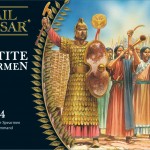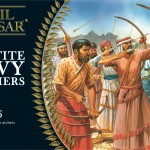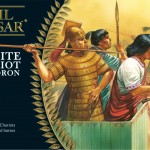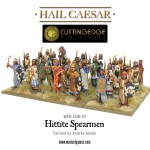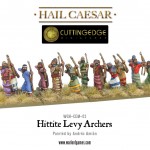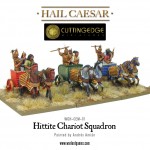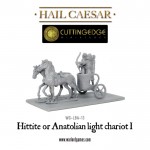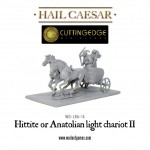In this series of articles, Bronze Age expert Nigel Stillman discusses the Battle of Kadesh and the period of war and battle between the Hittites and Egyptians that led to it. In this final part in this series, Nigel brings the battle to a climax and examines the outcome…
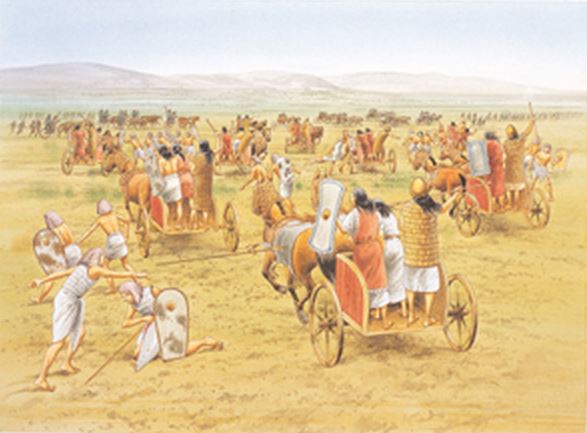
Courtesy of Osprey Publishing
Chariots attack!
While the council of war was meeting; Muwatalli gave the signal for the massed chariotry of the Hittites and their allies to attack; ‘Then he let go the chariot troops, an exceedingly large number, like the sand, being three troopers to a span . Now they had made their teams thus; among every three maryannu was one Hittite and they were equipped with all the weapons of warfare.’ The chariots, ‘crossed over the ford which is to the south of Kadesh, and broke through the middle of the Army of Ra while they were marching, unaware and unprepared for battle.’ This was a force of 2500 chariots organised in four ‘bodies’; which suggests four brigades with 625 chariots in each, assuming that the brigades were of equal size. A brigade of 625 chariots would include 25 squadrons of 25 chariot teams. The figures given in Egyptian records will be estimates based on their knowledge of enemy organisation, and the actual unit strengths and grouping were probably very varied. According to the battle scenes these units manoeuvred in line ahead and line abreast formation, altering from one to the other as required.
The Egyptian texts make special note of the innovative tactics of the Hittite chariot force: the addition of an extra crewman to the chariots. According to the scenes, this was probably combined with a new and stronger design of chariot, with the axle placed slightly further forward under the platform instead of the axle right at the back as in the Egyptian chariots. This alteration was made to improve strength whereas the normal design was intended to improve lightness and speed. We now know that the Hittites had tried this tactic before as shown on blocks belonging to lost battle scenes of Tutankhamun’s time, but these scenes had been dismantled and reused, so the tactics, now being used en masse and possibly as the standard tactics, came as a surprise to the Egyptians. The texts also hint that the Hittite and allied chariotry were equipped with ‘all the weapons of war’, which means the full kit for a chariot; javelins, composite bow and spear. Indeed, the battle scenes depict chariots armed with both spears and bows. It seems from one version of the Egyptian text that the Hittites had assigned Hittite third crewmen to allied chariots.
A bit further in the Egyptian text, at the point where the Hittite chariotry close in around the camp of the Amun army corps, it says; ‘So then his majesty went to look about him and he found 2,500 chariots surrounding him in on his outer flank, with all the runners (Peherer related to Egyptian verb ‘to run’) of the Hittites with the many foreign contingents which were with them from Arzawa, Masa and Pitassa, they being three men on a chariot acting as a unit.’ So it may be that chariot runners, specially trained chariot co-operation infantry, were assigned to chariots lacking three crew and suggests that the runners were Hittite soldiers assigned to Anatolian contingents. Presumably these chariots were strong enough to bear the weight and knew the tactics. Maybe the tactic was learned from fighting against the forces of Ahhiyawa (Achaea) in the west. Mursili had been waging a long western campaign for many years during the time of Seti I. Many of his troops would have been veterans of this campaign.
Egyptian texts say that Ramesses and the Amun army were making camp at a distance of 1 iter from the ford at Shabtuna, which is about 7 miles. The Army of Ra was crossing the ford and strung out in column of march when the Hittite chariotry charged, taking them by surprise. There was thus a gap between the camp and the marching column, which was unready to resist the onslaught. The oncoming Hittites may have been partly concealed by the valley of the Orontes, by vegetation or by morning mist and haze. It is unlikely that the Army of Ra could have reacted effectively even if the dust had given away the Hittite advance. The Hittite and allied chariotry seem to have attacked in columns, which would have enabled them to concentrate at weak points and surge through the gap. Egyptian chariotry that may have been acting as a flank guard were probably swept away and overwhelmed. The faster allied two crew chariotry could have dealt with these while the chariots carrying a third man could push on and dismount their runners to hold open any gaps that formed or were forced through the Egyptian column. It is said that the troops of Ra fell back before the Hittites, and so gaps doubtless appeared in front of the advancing chariots without having to plunge into the Egyptian ranks. Had the Egyptian infantry been ready for the attack, the spearmen would have formed deep columns, which were resistant to chariot attack, and would have been supported by massed archery. It would have been difficult for chariotry to approach such a battle line with success. The battle scenes show isolated stands of archers holding out as the enemy chariots sweep past them as well as soldiers ‘scampering away’ as the Egyptian text describes it.
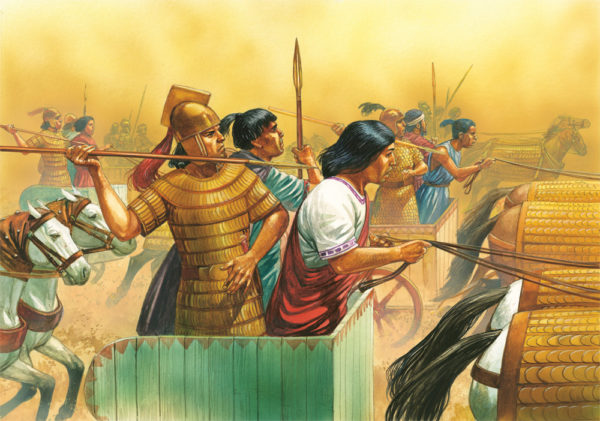
The Pharaoh is surrounded
The Hittite and allied chariotry swept around towards the north in a huge arc. The messenger arriving at the camp to tell the Pharaoh what had happened to the army of Ra got there only moments before fleeing survivors of the army of Ra pursued by leading waves of Hittite chariots. These cut off Ramesses and the camp of the Army of Amun from the rest of the Egyptian armies, one of which was now scattered and destroyed as an effective force. Ramesses says that he found the enemy in four bodies with chariotry and runners surrounding him on all sides. It seems that part of the encirclement was accomplished by using dismounted runners. So we can see the purpose of the tactic of mounting runners in chariots as third crewmen: it was not really to overwhelm other chariots, but rather to be able to drop off troops to hold open gaps and help surround enemy troops. Many hundreds of runners could have been dropped off, rapidly deploying well trained reliable infantry right in the midst of the enemy battle lines and right across their line of march. These would need to be overcome if the Egyptian units were to rally, regroup and link up with their comrades. Small isolated units would be wiped out by combined action of chariots and runners.
As they swept around the camp of the army of Amun, some Hittite and allied chariotry broke right into the still uncompleted camp. The camp had been surrounded by a palisade of shields but this had not yet been extended all around it. The chariots clattered between the tents, the crews looking for Ramesses or intent on looting. Ramesses himself was at this point isolated with his household chariots and Sherden bodyguard, and preparing to try and prevent the encirclement. A courier was sent to lead Ramesses’ wife Mutnofre (the only wife with him at Kadesh) and several princes to safety with the words, ‘do not go out on the west side of the camp and keep clear of the battle.’ Meanwhile the Sherden bodyguard were busy ambushing enemy chariots and dragging the crews from their vehicles to be mercilessly dealt with by long bronze slashing swords. These anecdotes are depicted in the battle scenes with hieroglyphic captions.
Ramesses was probably not intending to try and break out of the encircling Hittite chariotry; which may have been galloping round the camp like angry wasps or perhaps standing off and using their arrows javelins and runners to wear down Egyptian resistance. Ramesses perhaps hoped to hold out until couriers reached the other armies and hasten them on. It would not be easy to get through the melee and dodge the Hittite chariots for several miles before reaching the ford at Shabtuna. The as yet unengaged armies were still marching south of the ford. The army of Ptah was marching through the forest of Lebawy south of the town of Aronama, while the army of Sutekh was even further back and would not arrive in time to take part in the battle. Several chariot mounted officers, including the vizier himself as well as couriers on horseback, had set off to bring reinforcement so as to make sure at least some got through. Meanwhile Ramesses, who had been trying to rally fleeing soldiers (‘I kept on shouting to them, but not one of them hearkened to me’) decided to charge the Hittite chariotry in an effort to keep them back.
While there was still a chance to get away, Ramesses charioteer Menna offered some battlefield advice to his lord; ‘lets get clear and save ourselves!’. Ramesses replied, ‘stand firm, steady your heart, my shieldbearer, I will go into them like the swoop of a falcon, slaying and hurling them to the ground!’
He picked a point where the enemy seemed thinnest, which was the end of a column of chariots that was moving between the camp, the tell of Kadesh and the river Orontes. Ramesses in his chariot drawn by his horses Victory in Thebes and Mut-hotep, and followed by his pet lion ‘foe-slayer’ as well as his household chariotry, made repeated charges towards the Hittites. Turning about to get away from the attack, the Hittite chariots ‘plunged one upon the other into the river Orontes like crocodiles’. On seeing some of his chariotry recoiling and desperately trying to get back across the Orontes, Muwatalli ordered in his reserve of 1000 chariots, consisting of all the ally commanders of Arzawa, Masa, Ilion, Lukka, Dardany, Carchemish, Karkisa, Aleppo and his own Hittite brothers, with their personal retinues of chariots.
The Ne’arin Battlegroup reinforce the counter-attack
It was probably not just Ramesses counter-attack which caught the Hittite King’s eye, and the Pharaoh was no longer quite so alone in counter-attacking the enemy. Discreetly placed in the battle scenes are unexpected reinforcements accompanied by this caption, ‘The arrival of the Ne-arin of Pharaoh from the land of Amor. They found that the Hittite foe surrounded the camp of Pharaoh on its western side…while the army of Amun had not yet finished pitching camp and the army of Ra and the army of Ptah were marching and had not yet arrived from the forest of Lebawy. The Ne-arin broke into the hordes of the wretched overthrown one of Khatti as they were entering into the camp of Pharaoh, and the servants of his majesty slew them and did not let one of them escape.’ Quite probably, the Ne’arin initially encountered Hittite and allied chariotry who, thinking the battle was already won, had started to pillage the Egyptian camp. With the encirclement broken on the western side of the camp, and the Hittites that had got inside mopped up, the reinforcements were able to link up with Ramesses and join in the counter-attack. Now the Hittite reserve chariots were recoiling back into the Orontes, cutting their horses free from the chariots and riding them across and being dragged out of the water on the far side under the arrows of the Egyptians. The King of Aleppo almost drowned and is depicted in the battle scenes being turned upside down in efforts to revive him. By this time, battle fatigue and thirst must have been having an effect on the Hittite forces, now encountering fresh troops after having galloped for miles and fought the troops of Ra, Amun and Ramesses’ bodyguard. On the east side of the Orontes, Muwatalli watched, stationed between two huge masses of infantry, each numbering at least 8000 or 9000 men perhaps as many as 18000 and 19000. These are described as Tehuyeru, which seems to be a Hurrian word for ‘mercenaries’ or ‘free’ soldiers. Muwatalli chose not to commit any of these infantry into the battle. He knew that there were two more Egyptian armies on the march and he had already sent in his chariot reserve to try and finish off Ramesses.
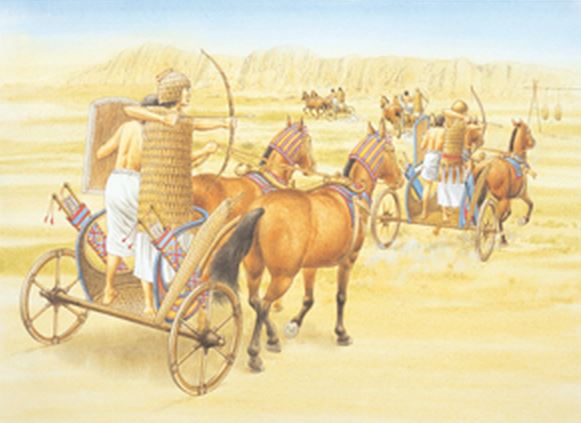
Courtesy of Osprey Publishing
Chariot Combat
Combat between opposing chariot squadrons was the decisive factor in this battle. The Hittites and their allies had to overpower any opposition from Egyptian chariots in order to dominate the battlefield. Egyptian chariotry had to do something to oppose the Hittite chariotry or leave their infantry and the Pharaoh to be surrounded, worn down, captured or wiped out. Egyptian chariot tactics emphasised the use of fast, lightly armoured chariots relying on shooting on the move with the composite bow and then veering away to avoid being caught up in a confused melee. Hittite tactics, and that of their allies, emphasised heavier chariots with more armour or even more crew, and the use of spears and javelins at close quarters as well as the composite bow. These chariots were equipped and ready to join in a confused melee, where they would usually prevail. They were less able to catch up with rapidly moving chariots. It would be difficult for Egyptian chariots to break through a resolute line of Hittite chariots which could sweep the Egyptians from the field. On the other hand, the Egyptians could turn about and lure the foe into range of their infantry archers and then regroup to counter-attack and pursue if the infantry repulsed the oncoming enemy chariots, being slow to turn about and rally back. Runners could be useful in covering such manoeuvres. There is a vivid scene of a chariot charge and counter-charge at Kadesh depicted on the walls of the temple of Abu-Simbel. It is best to look at an early copy of this before details and colours were weathered off. Recent excavations at Pi-Ramesses have discovered Ramesside chariotry stables with finds of horse bits of a type that would indicate manoeuvre and direction was very important in driving the horse team. Another recent find of a complete leather cover for a chariot shows that it was coloured in a ‘dragoon green’ edged in red (rather like the colour used by many French troops during Napoleon’s Egyptian campaign.)
The Stricken field and Pharaoh’s retreat
As the dusk descended over the stricken battlefield, the Hittite chariotry broke off the encirclement and retreated back across the Orontes as the hard marching Army of Ptah appeared in the distance. As night fell, the Egyptian survivors and stragglers began returning to the camp, apparently rallying when it became clear that the Pharaoh had not only survived against the odds but was ranting ecstatically; ‘What is wrong with you then, my officers who know not how to fight? Does not a man magnify himself in his city when he has acted valiantly in the presence of his lord? Good is a name won through fighting…A man is respected of old on account of his strong arm! Among the many hieroglyphic captions surrounding the battle scenes on the Egyptian temple walls is a caption giving the comments of an ordinary Egyptian soldier; ‘I am Nakhtamun the soldier…’ unfortunately the rest of the text is illegible.
During the night both sides drew back to lick their wounds, the Egyptians on one side of the Orontes and the Hittites on the other, with the city of Kadesh defiantly shut up against the Pharaoh. Next day Ramesses gathered together what was left of his army; ‘when the earth grew light, I marshalled the ranks for the fight.’ The Hittites, however, did not attack again. Instead they stood off apparently saluting Ramesses. Then a message arrived from the Hittite King Muwatalli offering a truce. Ramesses seized on the opportunity and called his officers together to hear the Hittite terms. Much relieved, they replied ‘Exceeding good is peace, o sovereign our lord. There is no blame in reconciliation….’, Ramesses ‘gave the command to hearken to his words and I made a move peacefully southwards.’ So the shattered Egyptian armies marched on the long road home, leaving the enemy in possession of both the battlefield and Kadesh. The Hittite army had no doubt suffered serious losses among the chariotry, but Muwatalli did not head for home. Instead, the Hittites warily followed the retreating Pharaoh southwards. Amurru had no choice but to submit to the Hittite King. Bentisina was deposed, but being a friend of Muwatalli’s brother Hattusili, who was also at the battle, was handed over to Hattusili as a hostage. He would later regain his throne. The Hittites advanced until they reached the land of Aba (Egyptian Upe, Damascus region), which was put under the command of Hattusili as he says, “…my brother Muwatalli campaigned against the King of Egypt and the King of Amurru, when he defeated the kings of Egypt and Amurru, he went back to Aba. When Muwatalli, my brother defeated Aba, he …went back to Hatti but he left me in Aba.” Two other brothers (Septher and Khemthrem) had been killed during the battle when the reserve chariotry had been sent in against Ramesses bodyguard and the Ne’arin battlegroup.
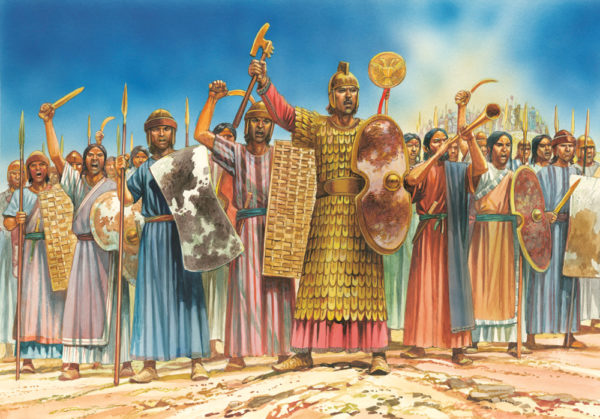
Hittite records claim victory
Back in Egypt, Ramesses gave orders for the battle to be depicted and described on the walls of the most important temples, as was the custom of mighty conquering Pharaohs. Everyone knows that the Egyptian account portrays the battle as a success and Ramesses as a Bronze Age hero who rescues his army from a dastardly trap, thus proving that the god Amun was on his side. This was quite normal for Pharaohs as well as for many other later rulers throughout history. The Hittite records report the battle thus; ‘When Muwatalli…became king, the people of Amurru broke faith with him and said… now we are your vassals no longer! They entered into the following of the King of Egypt. Thereupon Muwatalli…and the King of Egypt did battle with each other over the people of Amurru. Muwatalli defeated the King of Egypt and forced the land of Amurru to the ground with his weapons and subjugated it to himself.’ This implies that Amurru was left alone to be conquered by the Hittites while Ramesses retreated. If so where were the Ne’arin? Did they retreat with Ramesses or stay in Amurru as a rearguard or change sides? It is amazing how much truth and detail the Egyptians put into their battle report, they could have just been content with the usual bombastic text reporting victory over the ‘nine bows’, of far less interest to us, as did many other Pharaohs. My suspicion is that epic sagas, the prototype of the Iliad and the Biblical hero stories were already circulating at royal courts and Ramesses wanted to make his own mark in the genre.
Ramesses comes back, Assyrians attack, peace breaks out (c.1271 to 1258 BC)
In the years following the Battle of Kadesh, Ramesses campaigned in Canaan, repressing rebellions – some in the same areas where his father Seti had imposed Egyptian rule. Some of the records of these events are fragmentary or missing on the temple walls, but it appears that Ramesses probably conquered Jerusalem in year 8. In year 9 he had made another foray into Hittite territory, this time outflanking Kadesh to arrive in the region of Tunip where he stormed the city of Dapur by siege and assault.
Meanwhile, the kings of the remnant kingdom of Mitanni, known to the Assyrians as Hanigalbat, tried to impose their rule over Assyria or just survive against Assyrian expansion. They trusted in Hittite support, but received little. When Shattuara II rebelled against the Assyrian overlord, assisted by Hittite troops and Aramaean mercenaries he was defeated by Shalmaneser I and ‘pursued at arrowpoint.’ In the Hittite land, the new king Urhi-Teshub had proved incapable of deterring the Assyrian threat and was deposed by Hattusili, who took the throne as Hattusili III. Urhi-Teshub fled first to Babylon and then to Egypt where he disappeared or was hidden by Ramesses. The Assyrians had once already pushed as far as the Euphrates and almost taken Carchemish, and continued to do so as well as raiding along the Hittite frontier further north. The Assyrian king was almost within reach of Kadesh and it is interesting to reflect that a great battle could have been fought here between Hittites and Assyrians or Egyptians and Assyrians as well as Hittites and Egyptians, Egyptians and Mitannians and Hittites and Mitannians around this time.
The Assyrian threat, combined with the Pharaoh refusing to give up his ambitions, the insecure claim to the throne of the new king Hattusili III as well as potential trouble in the west against the Achaeans ands north against the Kaska, persuaded the Hittites to make a peace deal with Egypt. After negotiations in which the frontiers were agreed according to former treaties, leaving Kadesh in the Hittite domain, Ramesses and Hattusili drew up the famous peace treaty. The pact was sealed by marriage of a Hittite princess to Ramesses and so began a time of alliance between the two kingdoms that led to Egypt lending support to the Hittite kingdom during its later troubles.
Dating the Battle
There are several variants of the conventional chronology used in most books and there are also several versions of much shorter chronologies from 100 years to 300 years lower. As yet we cannot give the battle of Kadesh an absolute date as we can for the battle of Hastings. Fortunately, there are enough records for us to link up contemporary rulers and put together huge chunks of the jigsaw, which will later have to be fitted together or even overlapped as new evidence is found. I am in favour of a shorter chronology. Eventually the forensic science of archaeology will sort it out.
Some conventional chronology dates
- Reign of Tushratta c.1340’s-1330’s BC
- Reign of Suppiluliuma I 1344-1322 BC
- Reign of Ashur-Uballit I 1363-1328 BC
- Reign of Horemhab 1315-1295 BC
- Reign of Muwatalli 1295-1272 BC
- Reign of Ramesses II 1279-1213 BC
- Reign of Shalmaneser I 1273-1244 BC
- Battle of Kadesh 1275 BC (Ramesses year 5)
- Reign of Hattusili III 1267-1237 BC
- Egyptian-Hittite Treaty 1259 BC (Ramesses year 21)
Note that in any chronological scheme the dates may end up being fine-tuned by a decade or two!
Further Reading
- T. Bryce; The Kingdom of the Hittites,Oxford, 1999.
- A. Gardiner; The Kadesh Inscriptions of Ramesses II,Oxford, 1975.
- J.H.Breasted; Ancient Records of Egypt, Vol.3, Chicago, 1906.
- M. Lichtheim; Ancient Egyptian Literature, Vol. II, The New Kingdom, London, 2006.
- Internet; look at battlefield of Kadesh on Google Earth, Tell Nebi Mend, Syria.
Read the other Sections of this article:
History: The Battle of Kadesh part 1
History: The Battle of Kadesh part 2
History: The Battle of Kadesh part 3
History: The Battle of Kadesh part 4
History: The Battle of Kadesh part 5

